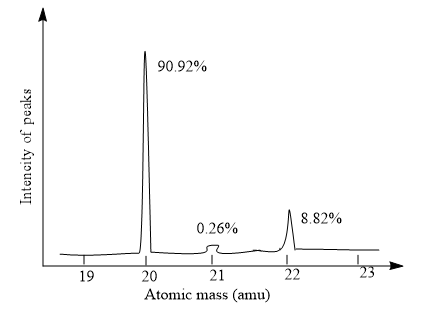
Have you ever noticed that when you reach into a bag of M and \[{M^1}\]s, that you are most likely to pull out a brown one?
A group of students studied the mass spectrum of a new element they wanted to name cadmium is shown below.
What is the relative atomic mass of cadmium?


Answer
500.1k+ views
Hint: Here, given a graphical representation of the mass spectrum of the element candium with, the intensity of peaks on the y-axis and atomic mass is along the x-axis. And it shows three peaks. And the tallest peak will indicate the base peak and it is a particularly stable ion. And the mass spectrum, which represents a plot of intensity vs m/z ratio. And m/z ratio indicates the mass to charge ratio.
Complete answer:
In the given plot, the base peak shows at the atomic mass $20$ and the intensity of the peaks is equal to \[90.92\% \]. And the element with atomic mass $21$ shows the intensity of the peak at\[0.26\% \]. The element with atomic mass $22$ shows the peak with intensity \[8.82\% \].
The relative atomic mass of an element is the sum of the product of the percentage of peaks and the atomic mass and the formula of relative atomic mass can be written as,
\[\Sigma \% \,of\,peaks\, \times atomic\,mass\]
\[20 \to 90.92\% \]
\[21 \to 0.26\% \]
\[22 \to 8.82\% \]
Substitute the values in above equation, will get,
Relative atomic mass\[ = \dfrac{{90.92}}{{100}} \times 20\, + \,\dfrac{{0.26}}{{100}} \times 21\, + \,\dfrac{{8.82}}{{100}} \times 22\]
\[ = 18.184 + 0.0546 + 1.9404\]
\[ = 20.179\]
Hence, the relative atomic mass of candium is equal to \[20.179\].
Note:
From the given plot of the mass spectrum, we get the relative atomic mass of cadmium is equal to \[20.179\]. And it is a pattern that represents the distribution of the ions by using the mass to charge ratio. To read a mass spectrum, first, we have to identify the molecular ion and next to identify the fragmentation. And calculate the \[\Delta m\] of each peak. If there are any heteroatoms, identify them also, after that name the molecule.
Complete answer:
In the given plot, the base peak shows at the atomic mass $20$ and the intensity of the peaks is equal to \[90.92\% \]. And the element with atomic mass $21$ shows the intensity of the peak at\[0.26\% \]. The element with atomic mass $22$ shows the peak with intensity \[8.82\% \].
The relative atomic mass of an element is the sum of the product of the percentage of peaks and the atomic mass and the formula of relative atomic mass can be written as,
\[\Sigma \% \,of\,peaks\, \times atomic\,mass\]
\[20 \to 90.92\% \]
\[21 \to 0.26\% \]
\[22 \to 8.82\% \]
Substitute the values in above equation, will get,
Relative atomic mass\[ = \dfrac{{90.92}}{{100}} \times 20\, + \,\dfrac{{0.26}}{{100}} \times 21\, + \,\dfrac{{8.82}}{{100}} \times 22\]
\[ = 18.184 + 0.0546 + 1.9404\]
\[ = 20.179\]
Hence, the relative atomic mass of candium is equal to \[20.179\].
Note:
From the given plot of the mass spectrum, we get the relative atomic mass of cadmium is equal to \[20.179\]. And it is a pattern that represents the distribution of the ions by using the mass to charge ratio. To read a mass spectrum, first, we have to identify the molecular ion and next to identify the fragmentation. And calculate the \[\Delta m\] of each peak. If there are any heteroatoms, identify them also, after that name the molecule.
Recently Updated Pages
The number of solutions in x in 02pi for which sqrt class 12 maths CBSE

Write any two methods of preparation of phenol Give class 12 chemistry CBSE

Differentiate between action potential and resting class 12 biology CBSE

Two plane mirrors arranged at right angles to each class 12 physics CBSE

Which of the following molecules is are chiral A I class 12 chemistry CBSE

Name different types of neurons and give one function class 12 biology CBSE

Trending doubts
One Metric ton is equal to kg A 10000 B 1000 C 100 class 11 physics CBSE

What is 1s 2s 2p 3s 3p class 11 chemistry CBSE

Discuss the various forms of bacteria class 11 biology CBSE

State the laws of reflection of light

Explain zero factorial class 11 maths CBSE

An example of chemosynthetic bacteria is A E coli B class 11 biology CBSE




